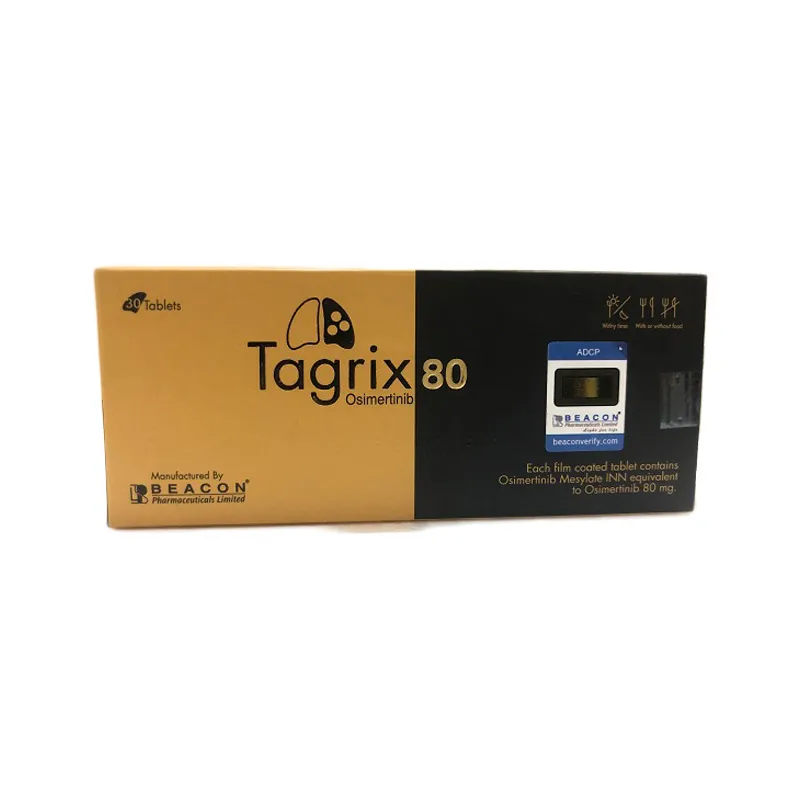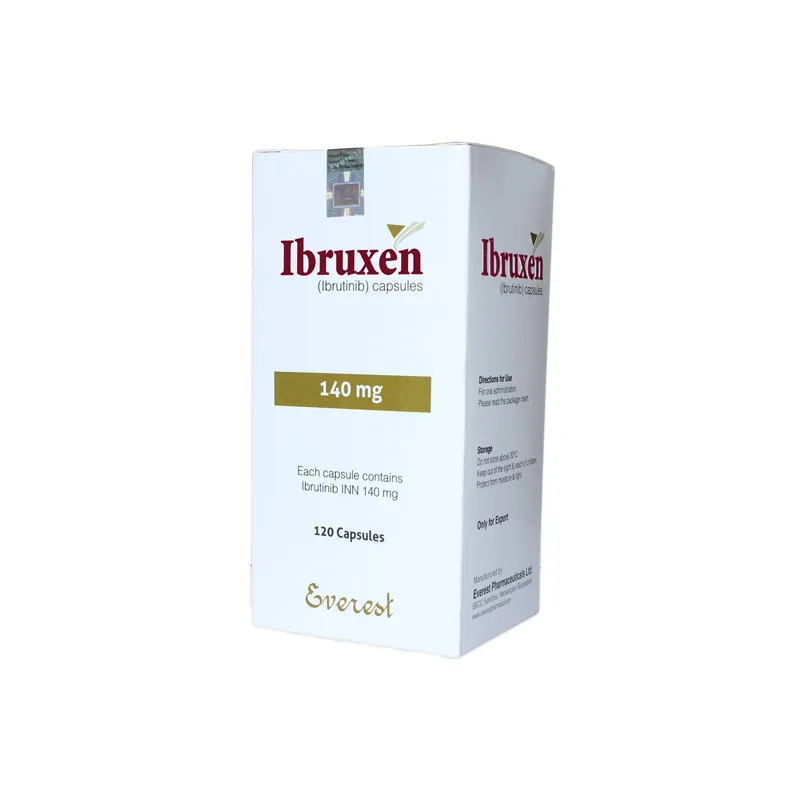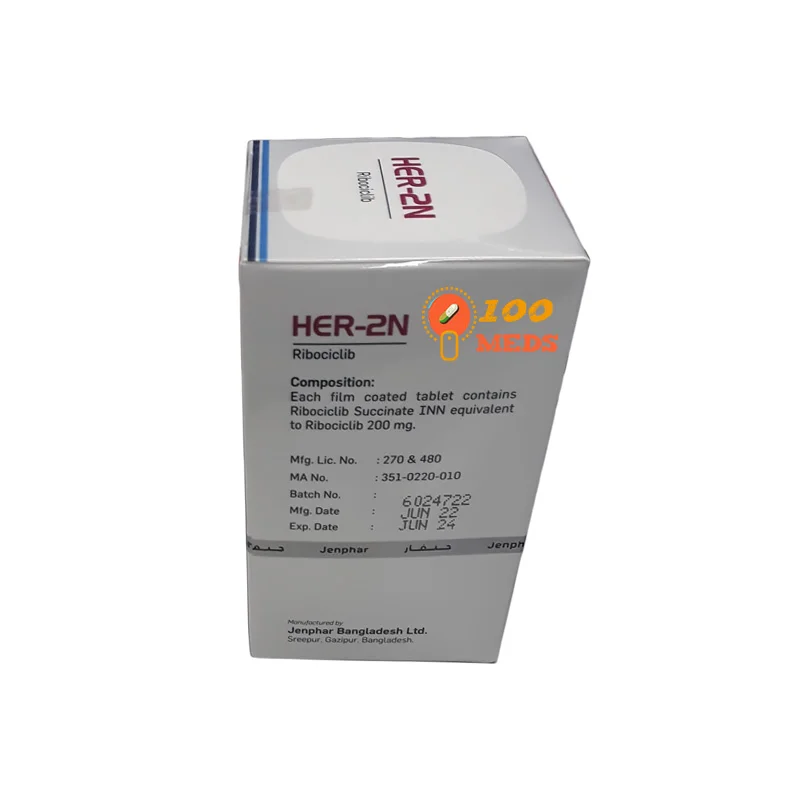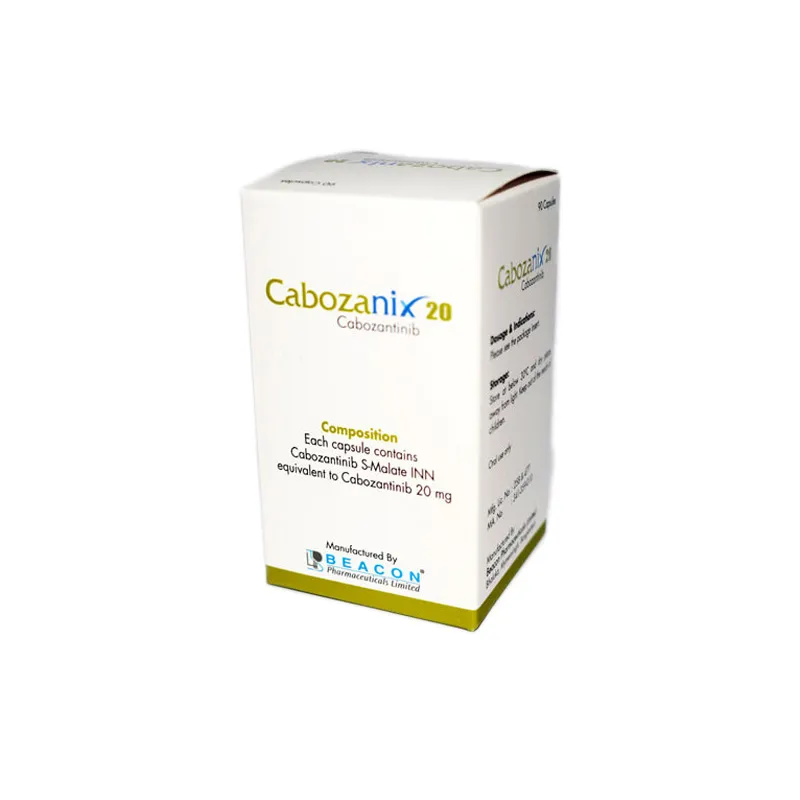Buy Tagrix 80 Mg Online
Inquire UsDescription
What is Tagrix 80 mg?
Tagrix 80 mg is a prescription medication that contains the active ingredient “Osimertinib“. It is used for the treatment of non-small cell lung cancer (NSCLC) that has a specific genetic mutation called epidermal growth factor receptor (EGFR) T790M.
Tagrix 80 mg is an EGFR tyrosine kinase inhibitor (TKI) that works by blocking the activity of EGFR proteins, which can fuel the growth and spread of cancer cells. By inhibiting EGFR, It can slow down or stop the growth of cancer cells and can also help to shrink tumors.
Osimertinib (Tagrix) is usually taken orally in the form of a tablet, and the dosage and duration of treatment may vary depending on the individual’s condition and response to the medication. It is important to take Osimertinib exactly as prescribed by the doctor and to follow all instructions carefully.
Why Should You Buy The Generic Tagrix 80 Mg Online?
Tagrix is a generic version of Tagrisso (Osimertinib). Without a health insurance facility, it is quite impossible to purchase Tagrisso for non small cell lung cancer patient. 30 tablets of Tagrisso 80 mg cost around 10,700 USD, Where you can buy generic Tagrix for only 270 USD. This kind of treatment required a longtime uses for a patient and it is impossible for a patient to continue the treatment. As generic Tagrix is affordable so any lung cancer patient can easily buy it. Buying medications online can be convenient, but it is important to be cautious and make sure that the website is legitimate and reputable. Some websites may sell counterfeit or substandard medications that can be harmful or ineffective. It is recommended to only purchase medications from licensed pharmacies and to consult with a healthcare provider before making any changes to medication regimens.
Tagrix Vs Tagrisso
Tagrix and Tagrisso are both medications used to treat non-small cell lung cancer (NSCLC) that has specific EGFR mutations. They contain the same active ingredient, Osimertinib, which works by inhibiting the activity of the EGFR protein found on cancer cells. However, the main difference between the two drugs is that Tagrix is a generic version of Tagrisso, which is manufactured by a different company, Beacon Pharmaceuticals Limited.
Despite being manufactured by different companies, both drugs are equivalent in terms of safety and effectiveness. One significant advantage of Tagrix over Tagrisso is that it is more affordable. While Tagrisso can cost up to $10,700, Tagrix is a more affordable generic version that costs only around $270. This makes it a more accessible option for patients who may not be able to afford the brand-name medication.
Composition:
Tagrix 80 Tablet: Each film-coated tablet contains Osimertinib Mesylate INN, equivalent to Osimertinib 80 mg.
Clinical Pharmacology of Tagrix:
The active ingredient in Tagrix 80 mg is Osimertinib, which is an oral, irreversible, third-generation epidermal growth factor receptor (EGFR) tyrosine kinase inhibitor (TKI) that selectively targets mutated forms of EGFR. Osimertinib has a higher affinity for mutated forms of EGFR compared to the wild-type (non-mutated) EGFR, which makes it a highly effective targeted therapy for patients with EGFR-mutated non-small cell lung cancer (NSCLC).
Osimertinib is rapidly absorbed following oral administration, with peak plasma concentrations occurring within 6 hours of dosing. It is extensively metabolized by the liver, primarily by the cytochrome P450 (CYP) enzyme CYP3A4, and is eliminated in the feces (68%) and urine (14%). The mean elimination half-life of osimertinib is approximately 48 hours.
The recommended dose of Tagrix 80 mg is one tablet once daily, taken orally with or without food. The duration of treatment may vary depending on the individual’s condition and response to therapy. It is important to follow all dosing instructions carefully and not miss any doses of the medication.
Clinical trials have demonstrated that Tagrix 80 mg is highly effective in treating patients with EGFR T790M mutation-positive NSCLC, with overall response rates of approximately 60–80%. It has also been shown to have a favorable safety profile, with the most common adverse events including diarrhea, rash, nausea, and fatigue. Rare but serious side effects include interstitial lung disease, QTc prolongation, and cardiomyopathy. Therefore, close monitoring and follow-up are necessary during treatment.
Pharmacokinetics of Osimertinib (Tagrix)
The pharmacokinetics of osimertinib, the active ingredient in Tagrix 80 mg, have been extensively studied in clinical trials. Osimertinib is an orally administered, small molecule, irreversible tyrosine kinase inhibitor that selectively targets mutated forms of the epidermal growth factor receptor (EGFR).
Following oral administration, osimertinib is rapidly absorbed, with peak plasma concentrations occurring approximately 6 hours after dosing. The absolute bioavailability of osimertinib is unknown, as the drug is insoluble in water and has a low systemic exposure in humans. Osimertinib is highly protein-bound, with a binding capacity of approximately 99.5% to human plasma proteins.
Osimertinib is extensively metabolized in the liver, primarily via the cytochrome P450 (CYP) enzyme system, specifically CYP3A4, CYP2C8, and CYP2D6. The major metabolite of osimertinib is AZ7550, which is less active than the parent drug. Osimertinib and its metabolites are excreted mainly via the feces, with only a small amount being excreted in the urine.
The elimination half-life of osimertinib is approximately 48 hours. Steady-state concentrations of osimertinib are reached within 3 weeks of daily dosing. Osimertinib exhibits linear pharmacokinetics over a wide range of doses.
Osimertinib exposure (AUC) increases in a dose-proportional manner over the recommended dose range of 40 mg to 160 mg once daily. There is no clinically significant difference in the pharmacokinetics of osimertinib between male and female patients, and no dose adjustments are required based on age, body weight, or renal function.
Overall, the pharmacokinetics of osimertinib are favorable, with a low potential for drug interactions and a manageable adverse event profile. However, close monitoring and follow-up are necessary during treatment with osimertinib.
Specific Populations
Specific populations may require different dosages or precautions when taking Tagrix 80 mg (osimertinib) due to their unique physiological characteristics. Below are some examples:
Renal Impairment: There is no need to adjust the dose of osimertinib in patients with mild to moderate renal impairment (creatinine clearance (CrCL) ≥ 30 mL/min). However, there are no data available for patients with severe renal impairment (CrCL < 30 mL/min) or end-stage renal disease, and caution should be exercised in these populations.
Hepatic Impairment: Osimertinib is primarily metabolized by the liver, so caution is advised in patients with hepatic impairment. The recommended starting dose of osimertinib is 40 mg once daily for patients with moderate hepatic impairment (Child-Pugh B). The safety and efficacy of osimertinib have not been studied in patients with severe hepatic impairment (Child-Pugh C).
Elderly Patients: Elderly patients (≥ 65 years) have a higher incidence of adverse events associated with osimertinib, particularly diarrhea, compared to younger patients. Dose adjustment is not required, but caution should be exercised when treating elderly patients with Tagrix 80 mg.
Pregnancy and Breastfeeding: Osimertinib can cause fetal harm when administered to a pregnant woman. Women of childbearing potential should use effective contraception during treatment and for at least 6 weeks after the last dose of osimertinib. It is not known whether osimertinib is excreted in human milk, so breastfeeding should be discontinued during treatment with Tagrix 80 mg.
Pediatrics: The safety and efficacy of osimertinib have not been established in pediatric patients. The use of Tagrix 80 mg in this population is not recommended.
It is important to consult with a healthcare provider before taking Tagrix 80 mg, especially if you have any underlying medical conditions or are taking any other medications.
Indication
Tagrix 80 mg (osimertinib) is indicated for the treatment of patients with metastatic non-small cell lung cancer (NSCLC) whose tumors have epidermal growth factor receptor (EGFR) exon 19 deletions or exon 21 L858R mutations, as detected by an FDA-approved test, and who have progressed on or after EGFR tyrosine kinase inhibitor (TKI) therapy.
It is also indicated for the first-line treatment of patients with metastatic NSCLC whose tumors have EGFR exon 19 deletions or exon 21 L858R mutations, as detected by an FDA-approved test.
It is important to note that Tagrix 80 mg should only be used in patients whose tumors have been identified as having EGFR mutations. The use of Tagrix 80 mg in patients with NSCLC whose tumors do not have EGFR mutations is not recommended. It is also important to have an FDA-approved test to confirm the presence of EGFR mutations before starting treatment with Tagrix 80 mg.
Dosage And Administration
The recommended dosage of Tagrix (osimertinib) is 80 mg orally once daily, taken with or without food. The tablets should be swallowed whole and not crushed or chewed.
For the treatment of metastatic non-small cell lung cancer (NSCLC) with EGFR mutations:
First-line treatment: Tagrix 80 mg should be continued until disease progression or unacceptable toxicity.
Treatment after EGFR TKI therapy: Tagrix 80 mg should be continued until disease progression or unacceptable toxicity.
Dose modification may be required based on individual patient factors:
- If a dose is missed, it should be taken as soon as possible on the same day, but the patient should not take an extra dose to make up for the missed dose.
- For adverse reactions, treatment with Tagrix may need to be temporarily interrupted or permanently discontinued, or the dose may need to be reduced.
- For moderate or severe hepatic impairment, the recommended starting dose is 40 mg once daily.
It is important to follow the dosage and administration instructions provided by the healthcare provider, as well as any additional instructions provided on the product label. Do not stop or change the dosage of Tagrix without consulting with a healthcare provider first.
Drug interaction:
Tagrix 80 mg (osimertinib) may interact with other drugs, which can affect the way the drug works or increase the risk of side effects. Some examples of drug interactions are:
Strong CYP3A Inducers: Co-administration with strong CYP3A inducers, such as rifampin, carbamazepine, phenytoin, and St. John’s wort, may decrease the exposure of osimertinib, reducing its efficacy. Concurrent use of Tagrix 80 mg with strong CYP3A inducers should be avoided.
Strong CYP3A Inhibitors: Co-administration with strong CYP3A inhibitors, such as ketoconazole, itraconazole, and clarithromycin, may increase the exposure of osimertinib, increasing the risk of adverse reactions. The dose of Tagrix 80 mg may need to be reduced when used concomitantly with strong CYP3A inhibitors.
Antacids: Concomitant use of antacids, such as aluminum hydroxide, magnesium hydroxide, and calcium carbonate, may decrease the exposure of osimertinib, reducing its efficacy. It is recommended to separate the administration of Tagrix 80 mg and antacids by at least 6 hours.
P-gp and BCRP Substrates: Co-administration with P-gp and BCRP substrates, such as digoxin and rosuvastatin, may increase the exposure of these drugs, leading to adverse reactions. The dose of P-gp and BCRP substrates may need to be reduced when used concomitantly with Tagrix 80 mg.
It is important to inform the healthcare provider about all the medications, supplements, and herbal products you are taking before starting treatment with Tagrix 80 mg. The healthcare provider can adjust the dosage of Tagrix or other medications to minimize the risk of drug interactions.
Pharmaceutical Information:
Storage Conditions
Tagrix 80 mg (osimertinib) tablets should be stored at a controlled room temperature between 20°C and 25°C (68°F to 77°F). They should be kept in their original container and protected from light and moisture.
It is important to keep the medicine out of the reach of children and pets. Unused or expired tablets should be properly disposed of according to local regulations.
Presentation & Packaging
Tagrix 80 mg (osimertinib) is available as film-coated tablets for oral administration. Each tablet contains 80 mg of osimertinib.
Tagrix 80 mg available in unit-dose blister packs for patient use. The blister packs contain total 30 tablets.
Tagrix 80 mg Price in Bangladesh, India, Pakistan, Nepal and Worldwide
We offer Tagrix 80 mg for only 270 USD. So you can purchase it from any country from our online store. To know more details please contact us.
Additional information
| Generic Name | Osimertinib |
|---|---|
| Brand Name | Tagrisso |
| Product Name | Tagrix |
| Manufacture | Beacon Pharmaceuticals Limited |
| MFG. LIC. NO. | 258 & 477 |
| Country Of Origin | Bangladesh |
| Pack Size | 30 Tablets |
| Treatment For | Non Small Cell Lung Cancer (NSCLC) |
You must be logged in to post a review.






Reviews
There are no reviews yet.